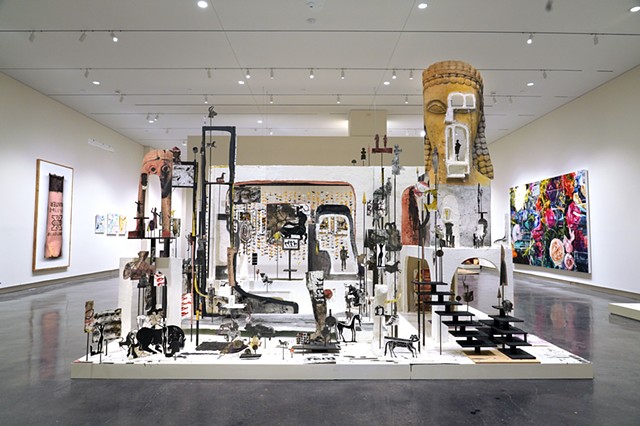BIO/ Andrew Scott Ross received his BFA from the Atlanta College of Art and his MFA at the School of the Art Institute of Chicago. He subsequently studied at the Skowhegan School of Painting and Sculpture. Ross has exhibited throughout the United States and abroad including; the Museum of Arts and Design in New York, the Building for Contemporary Art in Geneva, Switzerland, The Museum of Contemporary Art of Georgia, The Guggenheim Museum's Peter Lewis Theater, the Ben Gurion Airport in Tel Aviv, Israel, the Knoxville Museum of Art, the Hunter Museum of American Art, the Weatherspoon Museum, John Michael Kohler Arts Center, Mixed Greens Gallery and the Asheville Art Museum. His installation Century Zoo 10 was commissioned for the exhibit, Southern Voices / Global Visions organized by South Arts and ArtFields in 2023. In the summer of 2024, Ross’ wax drawings will be a part of the Delta Triennial at the Arkansas Museum of Fine Arts. His work has been reviewed in publications such as Artforum Magazine, Art in America, The New York Times, The New Yorker, Sculpture Magazine, and Artsy. Past awards include the Joan Mitchell Fellowship for MFA, The Tennessee Fellowship from the Center for Excellence in the Creative Arts, and the South Arts Fellowship for the state of Tennessee. Most recently, he received a 2022 Current Art Fund grant through Tri-Star Arts.
*STATEMENT/*For over twenty years, my creative research has been dedicated to exploring the language of museums and encyclopedic art history. This language encompasses the selection and presentation of culturally significant objects, as well as the socio- and psycho-cultural constructions embedded in these displays. My interest in this work originates from my childhood as a resident of New York City who regularly visited institutions such as The Metropolitan Museum of Art and the Museum of Modern Art.
The singular narratives of these museums, which have been frequently and rightfully critiqued in recent years, played a formative role in my upbringing. I have concentrated the majority of my studio inquiry on understanding their methods and discovering meaningful ways to deconstruct them.
Most often, the result of my research takes the form of large-scale installations that mimic the museological displays that I investigate. Original objects such as pottery and sculpture are replaced with drawn or sculpted representations that are easily manipulated, moved, or replaced. Finally, they are messy, layered, expressive, and stripped of the sleekness that typifies institutional presentations. My display does not promote the type of fixed historical narrative but one of uncertainty, self-reflection, and change.
I often directly embed these re-envisioned displays into museums, steps away from the artwork I reference. These pieces are never considered complete. They are exhibited multiple times in different institutions, continually exposing their evolution as elements are added or mutated and as parts are exchanged, sold, or eliminated. These shifting arrangements attempt to weave time and place while disrupting standard curatorial strategies such as chronological order or geographic specificity. I break down taxonomies and hierarchies by exchanging "high" and "low" art materials and intermingling human achievements with natural ones.
For example, my recent installation, Gallery of Thieves, models a museum's antiquity collection as the work goes through a process of synthesis with the rest of history. The work's individual elements start as Greek or Roman observations (charcoal drawings) and then go through a series of layering, chopping, and merging with non-Western, near Eastern, prehistoric, or contemporary representations. In this iteration, I continued to alter the artwork during the course of the exhibition that took place at the Asheville Art Museum. The museum's audience was able to watch as I transformed the work, in a performative fashion, in multiple sessions during regular open hours. During each session, Greek and Roman elements were literally torn from the display and replaced with a new set of images. These images depicted objects from people who lived in the Indus Valley, Mesopotamia, and the broader Levant and whose ideas or material processes shaped the cultural landscape of the ancient world.
